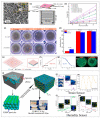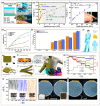An Overview of Polymer Composite Films for Antibacterial Display Coatings and Sensor Applications
- PMID: 37765645
- PMCID: PMC10536203
- DOI: 10.3390/polym15183791
An Overview of Polymer Composite Films for Antibacterial Display Coatings and Sensor Applications
Abstract
The escalating presence of pathogenic microbes has spurred a heightened interest in antimicrobial polymer composites tailored for hygiene applications. These innovative composites ingeniously incorporate potent antimicrobial agents such as metals, metal oxides, and carbon derivatives. This integration equips them with the unique ability to offer robust and persistent protection against a diverse array of pathogens. By effectively countering the challenges posed by microbial contamination, these pioneering composites hold the potential to create safer environments and contribute to the advancement of public health on a substantial scale. This review discusses the recent progress of antibacterial polymer composite films with the inclusion of metals, metal oxides, and carbon derivatives, highlighting their antimicrobial activity against various pathogenic microorganisms. Furthermore, the review summarizes the recent developments in antibacterial polymer composites for display coatings, sensors, and multifunctional applications. Through a comprehensive examination of various research studies, this review aims to provide valuable insights into the design, performance, and real-time applications of these smart antimicrobial coatings for interactive devices, thus enhancing their overall user experience and safety. It concludes with an outlook on the future perspectives and challenges of antimicrobial polymer composites and their potential applications across diverse fields.
Keywords: antibacterial; display coating; multifunctional; polymer composite; sensor.
Conflict of interest statement
The authors declare no conflict of interest.
Figures









References
-
- Alt F., Shirazi A.S., Kubitza T., Schmidt A. Interaction Techniques for Creating and Exchanging Content with Public Displays; Proceedings of the SIGCHI Conference on Human Factors in Computing Systems; Paris, France. 27 April–2 May 2013; New York, NY, USA: ACM; 2013. pp. 1709–1718.
-
- Jacucci G., Morrison A., Richard G.T., Kleimola J., Peltonen P., Parisi L., Laitinen T. Worlds of Information; Proceedings of the Proceedings of the SIGCHI Conference on Human Factors in Computing Systems; Atlanta, GA, USA. 10–15 April 2010; New York, NY, USA: ACM; 2010. pp. 2267–2276.
Publication types
Grants and funding
LinkOut - more resources
Full Text Sources

